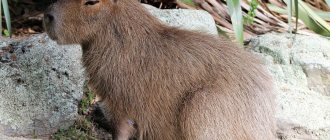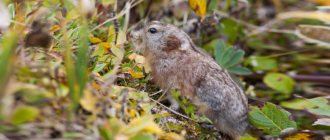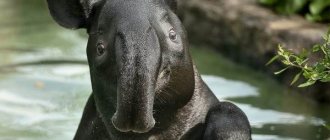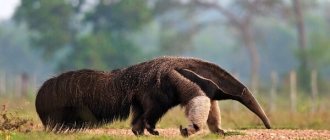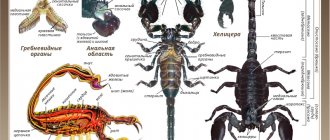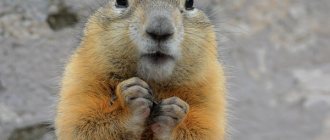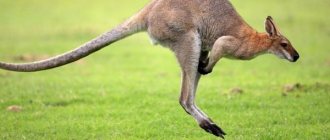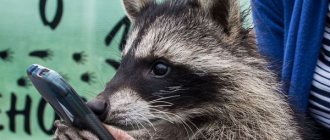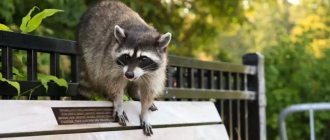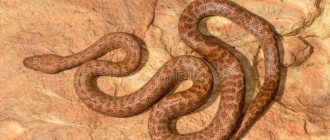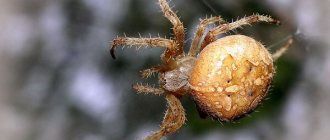Description of the roe deer
Roe deer is a small-sized deer. Males have small, double-branched horns. They appear in the second year of the animal’s life. In late spring, males always rub their antlers against trees to get rid of dead skin on them. The summer coat is dark red in color, the winter coat is gray-brown, thick, there is a white spot near the small tail. The same spots may be in the throat area. The muzzle is gray with black stripes from the nose to the corners of the lips.
Feeding characteristics of roe deer
— Advertising —
The roe deer is a herbivore, grazing early in the morning and at dusk. Its diet includes grass, young buds and tree leaves. Food is grasped with the help of the lower incisors and a hard chewing ridge on top and bitten off. In the autumn, when there is little grass, roe deer also eat nuts and other forest fruits (acorns, chestnuts, blueberries, sea buckthorn, beech fruits). Acorns, rutabaga, etc. are added to the winter diet. During severe frosts, roe deer gnaw young branches from trees.
Animal diet
During the warm period of spring and summer, roe deer live alone. It was during warm weather that the largest number of photos of roe deer were taken. During this mating season, the animal is individually responsible for comfort in its personal territory. Roe deer choose places densely overgrown with grass and bushes. In addition to the opportunity to eat plenty, herbivores in the thickets take refuge from the heat. Eat fruits and berries:
- blueberries and lingonberries;
- bird cherry and blueberry;
- apples and pears (picked from the ground);
- mushrooms.
When the free period ends, the animals have a hard time. The diet includes:
- bark from trees;
- dried roots;
- shoots of coniferous trees;
- rowan and viburnum.
Finding itself in snowy areas, the roe deer, having eaten all the vegetation still remaining on the surface, will dig through the snow in search of dried grass.
In captivity, roe deer live in zoos and nature reserves. The animals are fed grass, acorns and hay (in the cold season). There is a known case when a man found a month-old roe deer calf. At the zoo, veterinarians determined the age when the roe deer began to browse grass. The baby was also fed bananas and milk.
The article contains photographs of roe deer taken in nature reserves.
On average, animals live 8-10 years in the wild, and 12-13 years under supervision.
Roe deer distribution
The roe deer's habitat includes a strip of temperate climates in Europe and Asia to the Far East and Korea. In the west, it is found mainly the European roe deer (Capreolus Capreolus), in the eastern regions - the Siberian roe deer (Capreolus pygargus). For life, it prefers deciduous and mixed forests, as well as open areas, forest-steppes, and is found in the mountains up to a strip of eternal snow.
Population status
Currently, according to the WSOP classification, the European roe deer belongs to the taxa of minimal risk. Thanks to conservation measures in recent decades, the species has become widespread and common throughout most of its range; its numbers generally show an increasing trend. The population of Central Europe, the largest, is now estimated at about 15 million animals, although back in the 1980s. the number for the entire range was estimated at 7-7.5 million individuals. However, the rare and small subspecies Capreolus capreolus italicus Festa numbers no more than 10,000 heads; The Syrian population also needs special protection.
In general, due to their high fertility and ecological plasticity, European roe deer easily restore their numbers and, in the presence of suitable biotopes, can withstand relatively high anthropogenic pressure. The growth of livestock is also facilitated by actions to cultivate landscapes - cutting down clear forests and increasing the area of agrocenoses. Compared to other wild ungulates, the European roe deer has proven to be the most adapted to human-altered landscapes.
Common types of roe deer
- European roe deer, roe deer or wild goat (Capreоlus capreоlus)
Small graceful deer.
The body is short, the body is higher at the back than at the front. Males weigh from 22 to 32 kg, body length is 108-126 cm, height from 66 to 81 cm. Females are slightly inferior to males in size. The head is short, wide, tapering towards the nose. The ears are long, oval or pointed. The eyes are large and protruding. The neck is long. The limbs are long and thin. The tail is very small, up to 2-3 cm in length. The hooves are narrow and short. The horns of males are 15-30 cm long with three branches. Females do not have horns.
— Advertising —
Adult European roe deer are uniformly colored. In winter, they are gray or grayish-brown, less often grayish-red, and brownish-brown behind. The bottom of the body is light or yellowish-cream. The tail is surrounded by a white or light reddish spot. The legs become red at the bottom. The head and ears are red or brown. There is a white spot on the chin, and a black or gray-brown “whisker” stretches from the nose to the lips. Summer fur is uniformly red, the belly is whitish-red, the head is gray with a reddish tint and mustache.
- Siberian roe deer (Capreоlus pygargus)
The species differs from its European relative in its larger size (body length 126-144 cm, height from 82 to 94 cm, weight 32-48 kg) and long horns (27-33 cm).
The summer fur on the head is not gray, but red, the same color as the sides and back. The Siberian roe deer is distributed more east than the European one (Trans-Volga region, the Urals, Siberia, the Far East, Yakutia, Central Asia, China, Mongolia).
Reproduction
Male roe deer reach sexual maturity at the end of the first year of life. However, they cannot begin breeding offspring until their third year of life. They become physiologically capable of reproduction from March to October. But basically this process lasts from June to August. Only in a few people does this happen sooner or later.
Female roe deer are capable of reproducing offspring when they reach 14 months. Their estrus duration is usually 36 hours.
Roe deer behavior
In Europe, roe deer lead a sedentary lifestyle, occasionally changing pastures.
In winter, they move to areas where there is less snow and there are bushes and young bushes. Populations living in the mountains migrate seasonally. In winter, they descend lower in search of food. Roe deer live either singly or in herds of up to 10 individuals. They are active in the morning and at dusk, at which time they can often be seen. In case of danger, the animal raises its head and looks carefully in the direction of suspicious sounds, also pointing its ears there.
Roe deer breeding
Between the hooves of female roe deer there are special glands, from which an odorous secretion is released in July and August to inform the males that the mating period has begun.
Since spring, males have been carefully protecting their territory from strangers and attracting females without offspring. Males mark the boundaries of their territories with urine. They often fight and engage in fights with each other using their horns. They can cause serious injury to each other. Closer to the mating season, males leave their area and look for the marks of females. They follow the trail and pursue the female. Female roe deer experience delayed fetal development. Therefore, offspring are born from April to June, approximately 9 months after mating.
Life expectancy in natural conditions is 10-12 years, in captivity 19-25 years.
Popular message topics
The Beatles are a group that is among the TOP of the world's rock ensembles. The British band made a huge contribution to the development of rock music and rock culture. The group created the effect of an atomic bomb, which spread its music throughout the world in the 60s
Many people have never even heard of this flower, and that’s normal. Because it can be confused with others and not see its zest and uniqueness through which it stands out from others.
Moscow is the central city of our country, being the capital of Russia. This city is not only the capital of Europe, but of the whole world. All tourists strive to get to Moscow in order to see all the beauty that is in our city.
Source
Natural enemies of roe deer
In nature, roe deer become prey for most large and medium-sized predators.
Their main enemies are the wolf, lynx, and fox. Predators especially often attack cubs; these can be brown bears, badgers, raccoon dogs, martens, forest cats, golden eagles, eagle owls, and even wild boars. Stray dogs also cause damage to the population. In addition, roe deer suffer from infectious and parasitic diseases. The causes of natural mortality of animals also include exhaustion due to poor quality nutrition (winter-spring period) and high mortality of young males during the mating season and fights. Among the anthropogenic causes that affect the state of the roe deer population are hunting, poachers, motor vehicles, poisoning with mineral fertilizers and pesticides, and destruction of animal habitats.
Interesting facts about roe deer
- During mating games, female roe deer run from males in circles called “enchanted” circles.
- The last roe deer in England and Wales were killed by hunters in the early 18th century. In the 90s of the 18th century, animals were brought to these places from Scotland, and they gave rise to a new population.
- The Latin name of the species indicates its similarity to goats, which are called “capra” in Latin, and the Russian names of the species, such as wild goat, roe deer, and roe deer, are also similar. There is also a version that the name of the animal is associated with slanted pupils.
Economic importance
Roe deer occupies an important position in terms of economic importance. Firstly, these are hunting animals, since roe deer have very tasty meat, valuable skin and antlers. Secondly, these artiodactyls actively rid forest plantations of weeds that cause significant harm to forestry.
It is important to know! Roe deer has such valuable dietary meat that in some countries it is more valuable than wild deer, wild boar or hare.
The third, no less important factor is the aesthetic influence of the animal on wildlife, since the beauty of this animal is perceived by humans in a special way. Naturally, an uncontrolled increase in the number of such animals causes serious damage to forest plantations.
